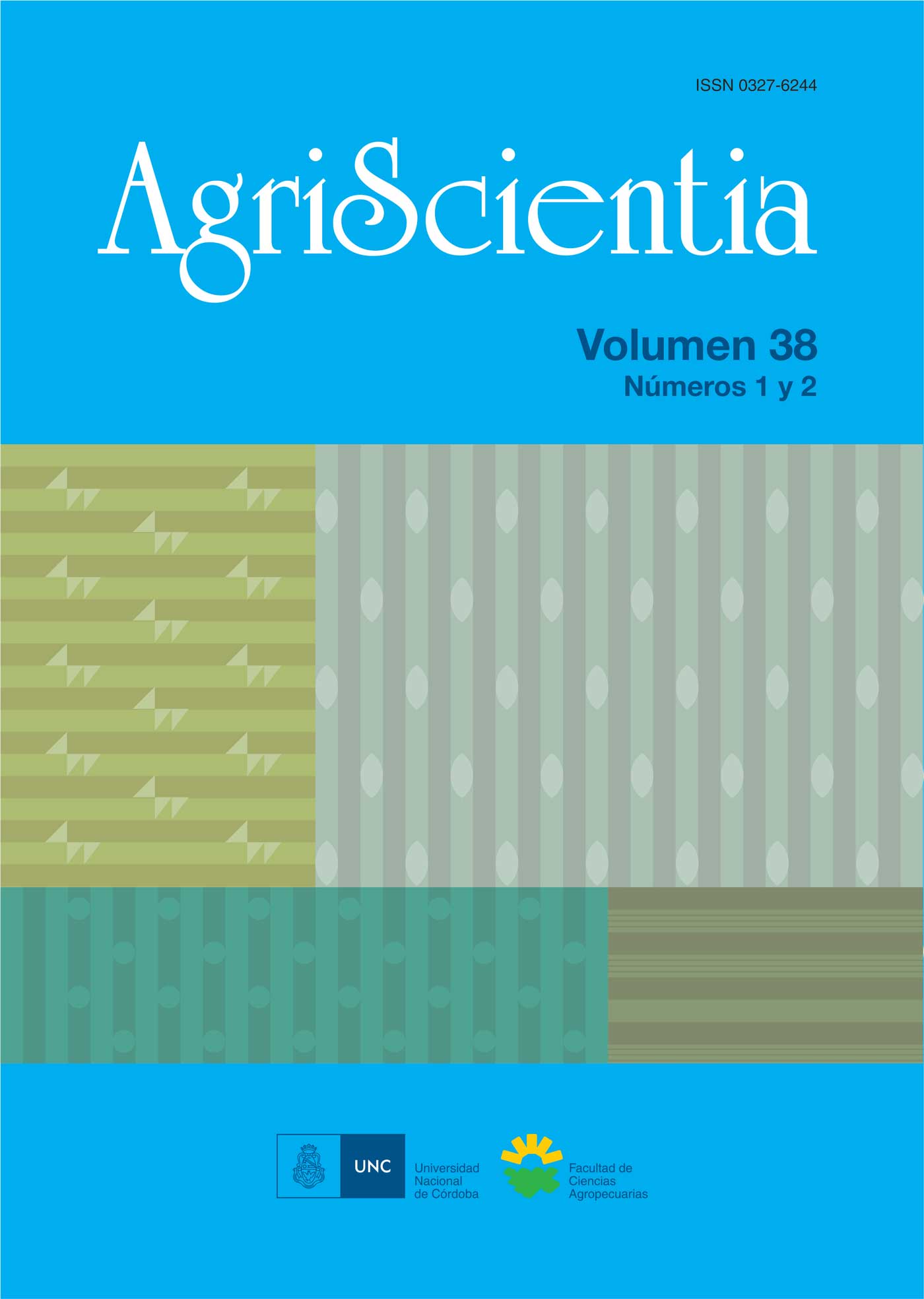Formulation and properties of coating biopolymer for peanut seeds (Arachis hypogaea L.)
Main Article Content
Abstract
This work shows a biodegradable coating biofilm design formulated with natural macromolecules such as starch, proteins, and glycerol, for its application on peanut seeds, to increase tegument resistance and fluency in sowing. Several formulations were assayed varying the concentration and types of starch. Two formulations, one based on corn starch and the other on cassava starch, were characterized in their rheology and their barrier, hydration and water solubility properties were determined. In coated seeds, biofilm technological characteristics, such as layer thickness, moisture absorption-desorption, contribution to fluency and mechanical damage resistance were tested. Seeds coated with biopolymer made up of 3 % cassava starch showed increased mechanical resistance and enhanced fluency and barrier properties. This work provides a formulation for the biopolimeric coating of peanut seeds, which being composed of natural, food grade and biodegradable substances, has the potential to be implemented in sustainable agriculture.
Article Details

This work is licensed under a Creative Commons Attribution-ShareAlike 4.0 International License.
How to Cite
References
Association of Official Analytical Collaboration (AOAC) International (2010). Moisture in feed 934.01 Official Methods of Analysis of AOAC International - M (18th
ed., 3rd rev.). Rockville, EstadosUnidos.
Badui Dergal, S. (1990). Química de los Alimentos (2a ed.). México, DF., México: Alhambra Mexicana.
Bolsa de Cereales de Córdoba (2019, Junio). Informe n° 167– Primera quincena de junio 2019 Informe de cultivos – Departamento de Información Agroeconómica. Recuperado de http://www.bccba.com.ar/images_db/noticias_archivos/4362Descargar%20informe.pdf#viewer.action=download
Bongiovanni, R, Troilo, L y Pedelini, R. (2012). Buenas Prácticas Agrícolas para la producción de maní. Córdoba, Argentina Instituto Nacional de Tecnología Agropecuaria-Argentina. Recuperado de https://inta.gob.ar/sites/default/files/script-tmp-manual_-_buenas_prcticas_agrcolas_para_la_produccin_d.pdf
Bourtoom, T. (2008). Review Article Edible films and coatings: characteristics and properties. International Food Research Journal, 15(3), 237-248. Recuperado
de: http://ifrj.upm.edu.my/15%20(3)%202008/01.%20Bourtoom,%20T.pdf
Breuninger, W., Piyachomkwan, K. y Sriroth, K. (2009). Tapioca/Cassava Starch: Production and Use. En J. N. BeMiller (Ed.), Starch: Chemistry and Technology (3a ed.) (541-568): Academic Press. DOI: https://doi.org/10.1016/B978-0-12-746275-2.00012-4
Secretaría de Agroindustria. Ministerio de Producción y Trabajo, República Argentina (2019). Cadena de maní – Resumen marzo 2019. Recuperado de: http://www.alimentosargentinos.gob.ar/HomeAlimentos/Cadenas%20de%20Valor%20de%20Alimentos%20y%20Bebidas/informes/Resumen_Cadena_2019%20Mani_MARZO_2019.pdf
Di Rienzo, J. A., Casanoves, F., Balzarini, M. G., González, L., Tablada, M., Robledo, C. W. InfoStat (versión 2008) [Software]. Córdoba, Argentina: Grupo InfoStat, FCA, Universidad Nacional de Córdoba. URL: http://www.infostat.com.ar
Gennadios, A., Weller, C. y Gooding, C. (1994). Measurement Errors in Water Vapor Permeability of Highly Permeable, Hydrophilic Edible Films. Journal of Food Engineering, 21,395-409. DOI: https://doi.org/10.1016/0260-8774(94)90062-0
Hema Prabha, P. y Vasudevan Ranganathan, T. (2018). Process optimization for evaluation of barrier properties of tapioca starch based biodegradable polymer film.
International Journal of Biological Macromolecules, 120 (Part A), 361-370. DOI: https://doi.org/10.1016/j.ijbiomac.2018.08.100
Jiménez Muñoz, F. y Martínez Rodríguez, F. (1996). Efecto de la humedad relativa sobre la estabilidad física de algunos sistemas ternarios utilizados en el diseño
de formas farmacéuticas liquidas de administración peroral.Revista colombiana de ciencias químicofarmacéuticas, 25, 60-70. Recuperado de: https://revistas.unal.edu.co/index.php/rccquifa/article/view/56468
López, O. y García, M. (2012). Starch films from a novel (Pachyrhizus ahipa) and conventional sources: Development and characterization. Materials Science
and Engineering, C 32, 1931–1940.DOI: https://doi.org/10.1016/j.msec.2012.05.035
Martucci, J. y Ruseckaite, R. (2010). Biodegradable Bovine Gelatin/Na+- ontmorillonite Nanocomposite Films. Structure, barrier and dynamic mechanical properties. Journal Polymer-Plastics Technology and Engineering, 49, (6).581-588. DOI:https://doi.org/10.1080/03602551003652730
Peressini, D., Bravin, B., Lapasin, R., Rizzotti, C. y Sensidoni, A. (2003). Starch–methylcellulose based edible films: rheological properties of film-forming
dispersions. Journal of Food Engineering, 59, 25–32. DOI: https://doi.org/10.1016/S0260-8774(02)00426-0
Pérez, S. y Bertoft, E. (2010). The molecular structures of starch components and their contribution to the architecture of starch granules: A comprehensive review. Starch/Stärke, 62, 389–420. DOI: https://doi.org/10.1002/star.201000013
Pineda–Gómez, P., Coral, D., Arciniegas, M., Rorales–Rivera, A. y Rodríguez García, M. E. (2010). Papel del agua en la gelatinización del almidón de maíz: estudio
por calorimetría diferencial de barrido. Ingeniería y Ciencia, 6(11), 129–141. Recuperado de: http://www.scielo.org.co/pdf/ince/v6n11/v6n11a08.pdf.
Rankin, J., Wolff, I., Davis, H. y Rist, C. (1958). Permeability of Amylose Film to Moisture Vapor, Selected Organic Vapors, and the Common Gases. Industrial and
Engineering Chemistry, 3(1) 120–123. DOI: https://doi.org/10.1021/i460003a023
Rojas Barahona, A. y Aristizábal Torres, I. (2011). Efecto del contenido de humedad sobre propiedades físicas de la semilla de vitabosa (Mucuna deeringiana). Revista de la Facultad Nacional de Agronomía de Medellín, 64 (1) 5961-5971. Recuperado de: http://www.scielo.org.co/pdf/rfnam/v64n1/a19v64n01.pdf
Steffe, J. (1996). Rheological methods in food process engineering (2a ed.). East Lansing, Estados Unidos: Freeman Press.
Wheatley, C., Chuzel, G. y Zakhia, N. (2003). CASSAVA / The Nature of the Tuber. En B. Caballero, P. Finglas, F. Toldrá (Eds.), Encyclopedia of Food Sciences and Nutrition (964-969). Academic Press.
Willett, J. L. (2009). Starch in polymer compositions Ch J. BeMiller and R. Whistler (Eds.) Starch Chemistry and Technology Food Science and Technology (715-
743) EstadosUnidos. Elsevier Science. DOI: https://doi.org/10.1016/B978-0-12-746275-2.00019-7
Woodruff, C., Peck, G. y Banker, G. (1972). Effect of environmental conditions and polymer ratio on water vapor transmission through free plasticized cellulose
films. Journal. Pharmaceutical Sciences, 61, 1956-1959. DOI: https://doi.org/10.1002/jps.2600611214C





